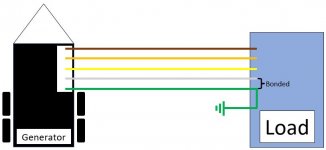I apologize in advance as I know this subject has been discussed exhaustively, but I feel my application is a bit unique, although similar to a thread started by superdave02 in September 2021 titled "Louisiana Emergency Generators". The majority of our business is with local electric utilities... We provide temporary power via mobile diesel generators anywhere from 20kW to 2MW for either emergency outages or planned ones (i.e.-system upgrades). I would estimate that 75% of the time we are connecting our generators to either the secondaries of a pad transformer or overhead directly to the secondary crib (other 25% of the time were going directly to the customers gear). In the case of a pad transformer connection, we usually connect the generator 1-of-3 ways...
- connect the generator leads directly to the secondary bushings (primary elbows/terminators stood-off/lifted)
- lift the secondaries off the bushings and connect the generator leads back-to-back on the secondaries
- connect the generator leads directly to the secondary bushings, but leave the primaries connected so we can backfeed the transformer via the secondaries and pick up multiple transformers connected to the same primaries

